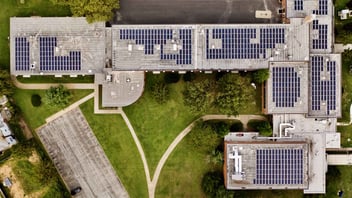Will Installing Solar Panels Damage My Roof?

There are many responsibilities for a commercial building owner. They range from maintenance repairs to meeting health and safety regulations, financial management, property management, and more. When considering rooftop solar for your business, wondering if solar panels will damage your roof should be the least of your concerns. So, will they? In most cases, your roof can remain unharmed – if you choose the right mounting system. This is why Catalyst Power uses ballast-mounted systems to keep your solar panel system grounded and your roof protected.
Let’s explore some common differences in typical solar panel installations and why a ballast-mounted system is the best for your commercial rooftop.
What’s the Difference Between a Ballast System and an Anchor System?
In your research, you’ll find that panel mount systems vary! There are two main methods for mounting rooftop solar panel systems (although there are other systems to consider, too). One of the more common systems is called an “attached racking” system. This system will penetrate your roof and, as a result, can cause damage.
Another standard mounting system is the “ballasted racking” or ballast-mounted system. A ballast-mounted system is:
- Simple to install because it uses extra weights, i.e., ballasts, instead of screws to support and hold solar panels in place.
- Can only be used on flat roofs and require no penetration.
Catalyst Power uses ballast-mounted systems for its customers. Why? It’s a non-invasive solar panel mounting system designed specifically for flat roofs, protecting your roof and ensuring durability.
Another mounting system is the “anchored” system. An anchored system utilizes the following:
- Wood screws to penetrate the roof surface and secure attachments.
- High-grade flashing as a permanent sealant against the elements.
Although attached racking systems can be used on sloped and flat roofs, they’re more challenging to install than a ballasted racking system. An anchored system means roof penetration, which can increase the risk of water damage or further roof damage.
Roof Type Considerations
Not all roofs are created equally, and different mounting systems are suited to other roof types. Different materials (asphalt shingles, metal, tile) have varying levels of durability and installation requirements, especially if you don’t have a new roof. For instance:
- Asphalt Shingles: These are generally compatible with solar installations; ensure they’re in good condition beforehand.
- Metal Roofs: These are often ideal for solar panels due to their longevity and ease of installation.
- Tile Roofs: Tile roofs require special attention during installation to prevent cracking.
A professional roof assessment and inspection will reveal whether your roof is ready for its solar debut!
Other mounting system types include ground-mounted, fixed-roof, and tilt mounts.
In Conclusion
The installation of solar panels isn’t an exact science, but with the proper installation and roof assessment, there’s no limit to what you can do with a ballast-mounted system. Not only are you protecting your roof, but you’re now on your way to lower energy bills, a smaller carbon footprint, and the satisfaction of being an eco-friendly business. With Catalyst Power’s expertise in rooftop solar installations, we ensure your roof is well-protected and ready to support solar energy solutions. You don’t have to sacrifice your roof’s structural integrity to achieve your solar goals. Ready for the next step?


%20(19).jpg?width=352&name=Untitled%20(1920%20x%201080%20px)%20(19).jpg)
